
Astronomy in Holiday Season.
Collected and arranged by Yasuharu Inugi
Printed in Reflections: December, 2006.
For astronomers living in Michigan, December isn’t really the best
time for observing. The long winter has just arrived, and the sky is covered
with
thick blanket of clouds most of the time. And if the sky is ever clear,
we have to deal with frigid conditions.
Yet for many of us, December is special time of the year. The sun is low
in south, moving from Scorpius to Sagittarius, and days are short. Soon
everything gets dressed with white stuff from the sky.
Maybe because it’s so grim, people use colorful lights to illuminate
trees and their houses—which may cause some light pollution but we care less
because the sky is mostly gloomy anyways.
December is also the holiday season: people take time off from the year’s
hard work and get together with their families. Outside, the air is cold, but
somehow it feels warm inside with all the familiar faces around you. Children
are all excited because they expect to receive presents from Santa.
Oh, I must warn you about Christmas presents. If you happen to be a Santa
for your family, be very careful what you give to your children. What a
child receives as a Christmas gift may have significant impact on their
life path. Telescopes are especially very dangerous. Here is a good example,
a story about a poor kid whose life had been forever changed because of
a present from Santa:
“For Christmas, 1966, Santa left a large silver-foil wrapped box under
our tree in suburban Allen Park. It took up one whole side it
seemed while my brothers’ and sisters’ had smaller packages.
How did he possibly get it down the chimney? I tore it open Christmas morning
to reveal a new Tasco 4.5” Newtonian, wow! (I later
learned it cost Santa around $400 from Hudson’s Northland store! That
was a LOT of money in 1966.) Fearing that moisture and cold
winter air might damage my new prize I would stay inside and aim through
our large double pane picture window at whatever I could see.
I read a story that Mars was in the eastern sky where I was looking, but
it was with great disappointment I could see little detail other than
a distorted orange colored point of light... or so I thought. Mars, it
would turn out, was really good ol’ Arcturus—duh!
It would be a week or two before the real planet appeared to me, whew.
I was hooked. Spring warmth eventually had me outside, recalling
the Pleiades high in the west as the first deep sky object I would visit.
How beautiful and sharp I thought compared to my indoor
views, cool! Being near the eastern approach to Metro Airport however is
what really honed my observing skills. I would get home from
school and often spend an hour or more tracking jets on final approach,
carefully recording the airline, type of aircraft, and time
(Northwest did not have a monopoly then). Try tracking a moving aircraft
with an ungainly equatorial mount.
The scope still resides here in my office at the University four decades
later.”

(Norb Vance, Director of EMU’s Sherzer Observatory)
So don’t ever give your child a telescope if you want him or her to
be a lawyer or a doctor. Or they may
end up making a life career in this geeky field of astronomy.
Speaking of December, I, as a “lowbrow” astronomer, also feel
this month is very special. Where I grew up
in Japan, the weather was quite different. The winter days were typically
clear but cold and windy. I still
remember a day in my childhood when I was sledding at dusk and it was getting
dark around, and I noticed the sky was filled with all the stars.
Perhaps it was the first time when I noticed the beauty of the night sky.
It was probably December, because
I somehow have a Christmas tree somewhere in the same scene (yes, we do
have Christmas trees over there.) Then in high school, a friend
of mine had a department store 50mm refractor and we looked at Mars, Jupiter,
Saturn, Pleiades, etc. I got hooked and later got a 100mm reflector
and picked up star gazing for a while. Then I quit it—As a youngster my
interest had shifted to other things. I was totally absent from star gazing for
about twenty years. Then a couple of years ago, it all of a sudden came
back to me again. I joined this club, went to John Causland’s house (again
it was this time of the year) to join a casual observing session, and boy,
I got hooked again!
I believe some of you also have memorable star gazing stories around this
time of the year. I wanted to know if others have any favorite objects
they like to observe or associate with, particularly in holiday season.
To help me writing this article, I asked the lowbrow members to vote for
their favorite deep sky objects for holiday season. I got a good number of
responses with reasons why they like them (thanks to all who responded).
I summed up the results and sorted them from the most popular one.
So here we go: The following is the list of favorite “deep sky”
objects for the holiday season, chosen by the Lowbrows.
(Extracts of voters comments are shown in Italic):
***** No. 1 (8 votes) *****
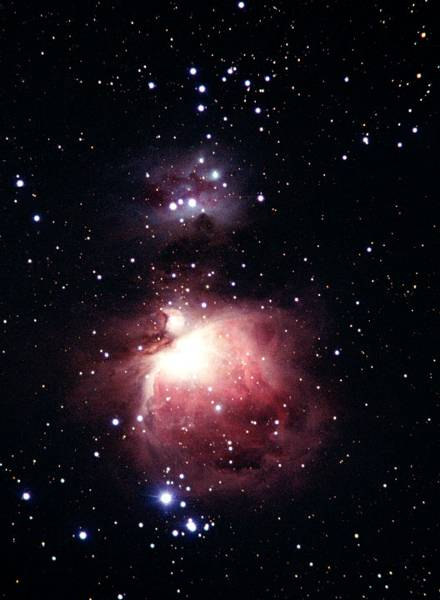
The Great Orion Nebula (M42+M43)
-
Type: Emission nebula and cluster
- Cons: Orion
- Visual Magnitude: 3.7 (M42)
- Dimension: 1.5°x1.0°
- Distance: 1500 l.y.
“The Orion Nebula is probably the most appropriate Christmas time
object since it sort of resembles a
Nativity or a manger scene—at least it does to me. And the nebula really
has given birth to the glowing
Trapezium. The beauty is metaphorically and visually astounding.”
“The Orion Nebula because it looks like a celestial ‘gateway
to heaven.’ ”
“These are the first two nebulas I was introduced to some 25 years
ago through a Celestron 90mm “first
scope” refractor. I have been hooked ever since.”
Without doubt, the great Orion’s nebula (M42+M43) is one of the most
spectacular deep sky objects in
the winter sky. It is easily found by naked eyes, as being the middle “star”
of Orion’s sword. Through
binoculars the nebulosity can easily be spotted. A small telescope reveals
details of the nebula’s structure
and four new born stars (Trapezium) inside. Larger aperture can detect
up to six (or more?) stars
in Trapezium under a good condition. In low or high power, it is truly
great looking, especially under a
dark sky. I am sure that Orion’s nebula had hooked many people into
astronomy.
***** No. 2 (5 votes) *****
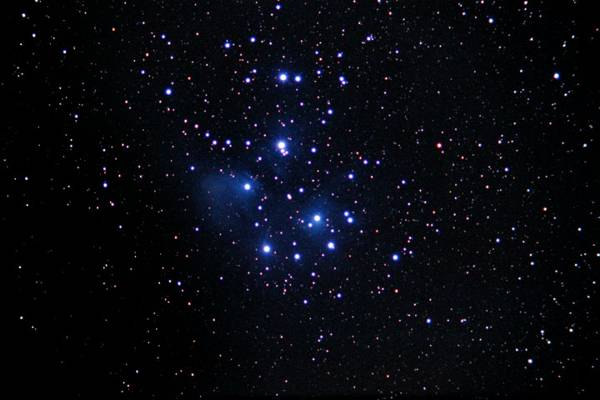
Pleiades (M45)
-
Type: Open cluster
- Cons: Taurus
- Visual Magnitude: 1.5
- Diameter: 2°
- Distance: 407 l.y.
“Easily found, easily seen, remember them from when I was a child
(Xmas is a nice
family time so those remembrances are nice).”
“I guess, because they (here he is talking about both M42 and Pleiades)
are naked eye
objects that I’ve seen most of my life and have never seen through
a telescope until just
a couple of years ago. I’ve always been very curious about them. There
have been
many Christmas Eves on the way to the midnight church service where I’ve
looked up
and wondered what they are. The winter sky seems like an even smattering
of stars
until you run across these two objects. They almost appear as flaws or
smudges like
dead bugs on a windshield. But through a scope or binoculars on a clear
winter night, they are absolutely amazing. The Pleiades is just dazzling
to see through binoculars.”
Pleiades is one of the best objects for binoculars or naked eye observation.
It is a bright cluster and can easily be found even under a light polluted
sky. It is a good challenge to see how many stars in Pleiades you can recognize
with naked eyes. Most people with good eyes can see six or
seven, but some have seen more than ten!
Pleiades is also called “Seven Sisters”, the daughters of Atlas
in ancient Greek myth. In Japan, Pleiades is called “Subaru”,
meaning “gathering” or
“unification” of stars (in old Japanese language).
***** No. 3 and No. 4 (tie, 3 votes each) *****
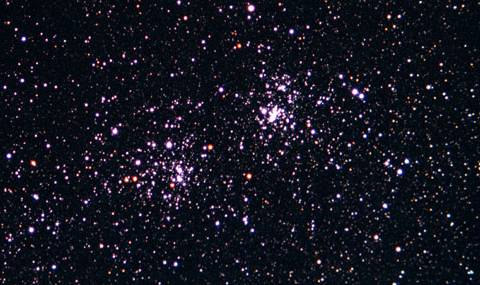
Double Cluster in Perseus (NGC 869 and NGC 884)
-
Type: Open cluster
- Cons: Perseus
- Mag: 3.5/3.6
- Diameter: 1.5° (each)
- Distance: 7100/7500 l.y.
“Stunningly beautiful in virtually any size scope.”
Though virtually visible year around, the double cluster gets votes because
it gets high
in the early evening sky in this season. The splash of stars you find in
the eyepiece is
just astounding. With careful observation you will notice difference in
colors of stars.
You may find quite a few red ones also. This is an ideal object for a child
(or anyone),
first night out with a new telescope.
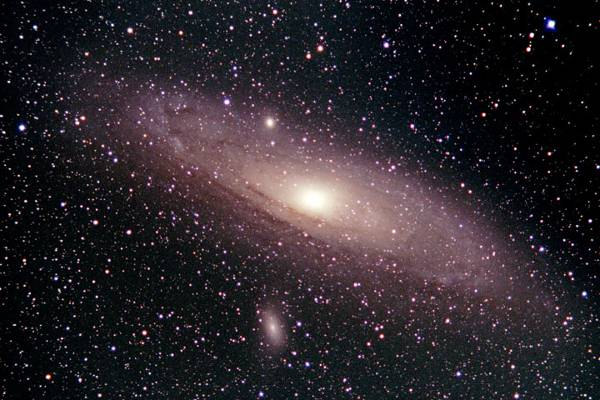
Andromeda Galaxy (M31)
-
Type: Spiral Galaxy
- Cons: Andromeda
- Visual Magnitude: 3.4
- Dim: 3°x 1°
- Distance: 2.3 million l.y.
“Beautiful in a wide field shot.”
This is another marvelous object in fall and winter sky. M31 is huge, the
visual dimension
is actually longer than five moons put together! In low power, you can
see its companion
galaxies M32 and NGC 250 in the same field of view. Under a black sky, you
will be able to see the dust lanes even with a small scope. This galaxy
is rushing towards
us at 185 miles per second and will eventually collide into our galaxy.
***** No. 5, No. 6, and No. 7 (tie, 2 votes each) *****
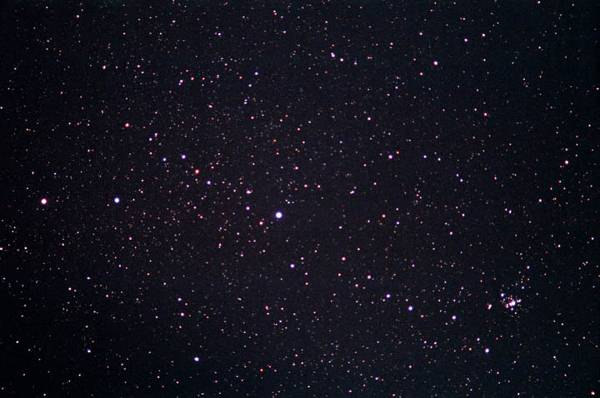
Kemble’s Cascade
- Type: Asterism
- Cons: Camelopardalis
- Visual Magnitude: Approx. 8
- Dim: 2.5°
- Distance: -
“Break out your widest field eyepiece or your binoculars for this
“cascade” of 25 10th to
7th magnitude stars that form a NW to SE line spanning 150 arc minutes
that seem to
pool into the small open cluster NGC 1502. If this one doesn’t bring
a smile to your face
then find a new hobby!”
Well, I cannot agree more. This elegant asterism appears to consist of
two parts, upper and
lower cascades and lower one flowing into NGC 1502. To find it, connect
Beta and Eta Cassiopeia
(two end stars of Cassiopeia’s “W” shape), and extending
about the same distance downward
(i.e., left of Capella) and look there with a pair of binocs.
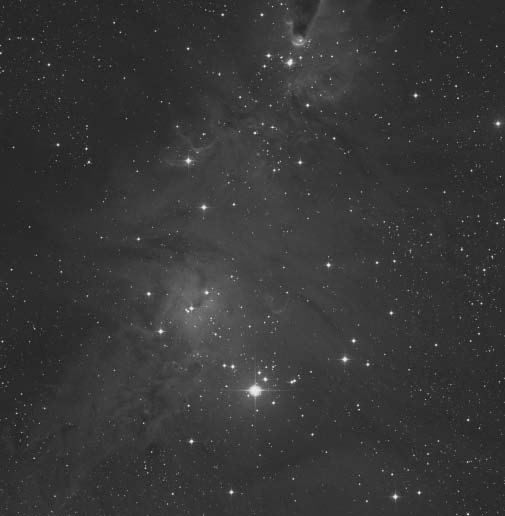
Christmas Tree Cluster (NGC 2264)
-
Type: Open Cluster
- Cons: Monoceros
- Visual Magnitude: 3.9
- Dim: 20’
- Distance: 2400 l.y.
“Stars in this large and bright cluster are arranged in the shape
of a Christmas tree. The brightest
star is at the base of the tree at the north end, with the tip of tree
pointing south, making it
upright in an inverting telescope. Very nice cluster!”
Not knowing NGC 2264 well, I had always thought that M103 was the best Christmas
tree looking
cluster. I had seen NGC 2264 only once before and didn’t remember how
it looked. I was curious
which one, M103 or NGC 2264, was a better Christmas tree mock-up, so one
night I compared
them one after another in the same scope. Well, for my surprise, I found
that NGC 2264 was a
lot larger and brighter! In NGC 2264, you can see the shape of a Christmas
tree even in
binocs, with a bright star being the trunk. Compared to that, M103 was
certainly much smaller (Mark
Deprest insulted it by calling it a “Charlie Brown Christmas tree”.)
So I decided to vote for NGC 2264.
But I’d like to give M103 a credit too: With larger scope in medium
power, M103 stands out very well,
with colorful stars inside, with a bright star at the top of the Christmas
tree. Which one do you prefer?
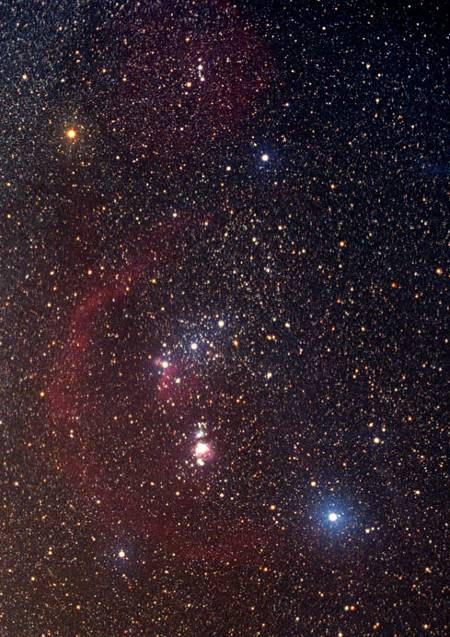
Constellation of Orion (2 votes)
“I always look for Orion’s belt and sword in the winter. It just
stands out on cold, clear nights.”
“During the winter months each day I look forward to seeing it.”
Though not normally regarded as an “object” to observe, the constellation
of Orion got votes here.
Orion is probably the most distinct and well known constellation in the
entire sky. It consists of many
bright stars and lots of interesting objects. Orion certainly represents
the winter sky, gracefully and
prominently.
***** No. 8 thru No. 15 (tie, 1 vote each) *****
There are so many beautiful objects to observe in the winter sky. The following
objects, though they
got only one vote each, are all very nice. I sorted them in the order of
the length of the attached comments.
M35 and its Faint Companion NGC 2158
“I was able to get both (M35 and NGC 2158) in the same field of view
of my old Coulter 13-inch Dob. With M35 less than 3,000 light years away, and NGC 2158 being
16,000 light
years away, the view was truly three dimensional. I highly recommend that
object for viewing
in a fast dob on a clear and steady night if you haven’t seen it.
I think of this pair of open
clusters when the weather turns cold.”
HJ 3945 in Canis Major
“I like colorful double stars and this is one of the best! The 4.8
magnitude primary is reddish
orange and its 6.8 magnitude secondary is a beautiful sapphire blue,
they have a fairly wide
separation of 27 arc seconds. It’s less than two degrees due north of the
“The Mexican
Jumping Star Cluster” and it just seems to prove how truly beautiful
nature can be.”
The Mexican Jumping Star Cluster (NGC 2362)
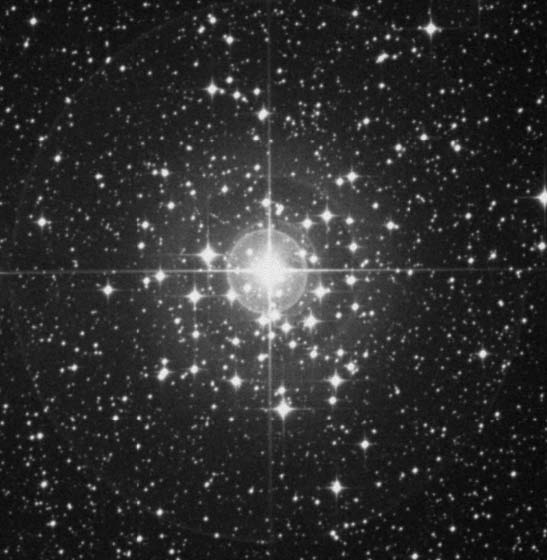
“I like this cluster for its apparent symmetry, being triangular
in shape with the 4th magnitude
Tau CMa at its center. This cluster is just “dog-gone pretty!”
Rosette Nebula/Cluster in Monoceros (NGC 2237, 2238, 2239, 2244 and 2246)
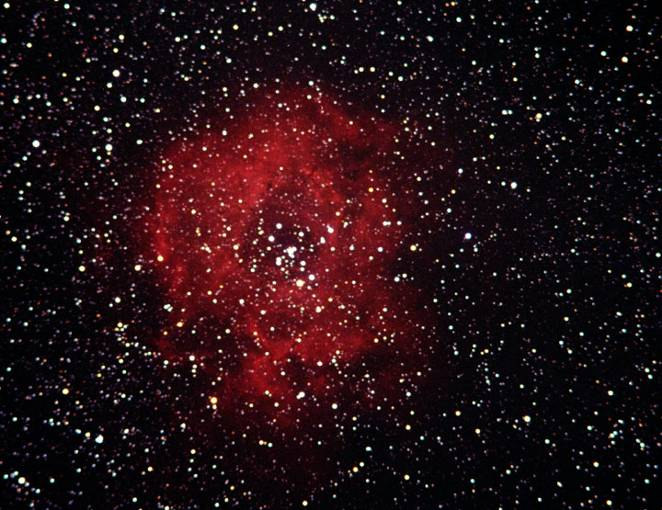
“It’s a beautiful cluster, and with a good nebula filter it’s
embedded within a wide
ring of nebulosity. It looks like a Christmas wreath!”
Helix Nebula (NGC 7293)
“It is so grand in a large telescope, showing lots of stars embedded
in the nebulosity.”
Crab Nebula (M1)
“It was one of the first winter objects I observed over 40 years ago.”
Eta Persei
“A beautiful optical double yellow and blue.”
M33
“A classic object.”
***** Other Objects *****
Here are other objects that got votes. Except for Capella, they are not
really “deep sky” objects. But I listed them here because the
reasons are
quite interesting. (The same person picked all these objects can you guess
who that would be?)
Saturn
“My wife bought me my first scope for Christmas two years ago. I fiddled
around with it for a bit, moving it randomly from star to star, and realizing
that looking at singular stars through the telescope just made that singular
star look brighter and gave it a little more color. Being somewhat disappointed,
I then put in the highest power eyepiece I had at the time and pointed
it at the brightest ‘star’ I could find. I tweaked the focus
a bit and that
luminous doughnut (I have a Mak) turned into a very sharp, clear, ringed
planet. I was awestruck. I was so excited I had the urge to crawl through
the telescope in order to get a closer look. I had seen many photos of
Saturn before, but there is nothing like seeing it on a cold clear winter
night.
My fingers were almost numb from the cold that night, but it was well worth
it.”
The Sun
“For old Sol to be up during the day can herald a possible clear night
to follow. We have so few clear days this time of the year, so it is nice
to see
the Sun. A few years ago we even had a partial solar eclipse on Christmas
day. What a good reason to excuse yourself from a visit with the relatives
to go out side and do some observation.”
The Moon
“Another memorable night near the holiday season was when there was
a lunar eclipse. A handful of Lowbrows showed up, and soon it started
snowing. Not a little, but a lot. Great big chunks of wet snow. We still
managed somehow to see the Earth’s shadow creep across the face of the
Moon. We all agreed that we were true ‘lunatics’ on that evening.”
Capella
“My interest in observational astronomy was kindled by reading the
then best seller, A Brief History of Time by Stephen Hawkings. Having done a
bit of reading about cosmology, Hawkings book actually made me go outside
and look up at the night sky and think about some of the ideas he
was discussing in his book. The bright star Capella up; and, was exactly
the same number of light years away as my age at that time. The light I
was seeing at that moment left the star when I was born. How neat! Space-time
explained on a personal level.”
The Weather
“I have been observing with telescopes since 1992 when I first joined
the Lowbrows. I can honestly say that with November being the cloudiest
time of the year and December being a close second, that observing around
the Christmas season is a rare occurrence. All the shopping, travel,
partying, visiting, partying, and partying adds to reasons for not observing
during this time of year. But, observatin does happen... sometimes. I
remember once when Doug Scobel and I when out to Peach Mountain on a night
in December when, for the reasons above, nobody else showed
up. It could have also been because there was a wind storm a brewing. What
were we thinking? We commenced to do our observing right up
against the side of the observatory, and still we had to fight to keep
the scopes under control. We managed to eek out a limited list of objects
before
giving up for the night.”
***********
Though rare in this season, there certainly will be some clear nights.
If it is so, take your scope or binocs out, invite your family and friends, and
explore and show them the night sky. It’s packed with jewels. I wish
you all happy holidays and clear skies.

Photo Credits
- Photo of Norb Vance—courtesy Norb Vance.
- M42 & M43; M45; Double Cluster in Perseus; M31; Kemble’s Cascade; Orion; Rosette Nebula—Clayton Kessler.
- NGC 2264; NGC 2362—The STScI Digitized Sky Survey (see http://archive.stsci.edu/)
Links
Copyright Info
Copyright © 2015, the University Lowbrow Astronomers. (The University Lowbrow Astronomers are an amateur astronomy club based in Ann Arbor, Michigan).
This page originally appeared in Reflections of the University Lowbrow Astronomers (the club newsletter).
This page revised Tuesday, April 10, 2018 7:08 PM.
This web server is provided by the University of Michigan;
the University of Michigan does not permit profit making activity
on this web server.
Do you have comments about this page or want more information about the club? Contact Us.











